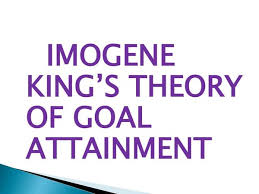Imogene King’s Theory of Goal Attainment in Nursing is a conceptual framework used extensively in nursing practice. The theory provides a comprehensive view of the nurse-patient relationship and emphasizes the importance of goal-setting and communication in achieving positive patient outcomes. This article will explore the key concepts of Imogene King’s Theory of Goal Attainment, its application in nursing practice, and how it compares with other nursing theories.
Imogene King’s Theory of Goal Attainment: An Overview
Imogene King developed her Theory of Goal Attainment in the early 1960s, during a time when nursing was transitioning from a task-oriented approach to a more patient-centered one. The theory is based on the idea that nurses and patients work together to achieve mutually agreed-upon goals. King believed communication, perception, and interaction were essential to this process. King’s theory consists of three levels: personal, interpersonal, and social systems.
The personal system concerns the individual’s perception and understanding of their health and well-being. The interpersonal approach focuses on the nurse-patient relationship and their communication and interaction. The social system looks at the broader context in which the nurse-patient relationship occurs, such as cultural and societal factors.

The Concepts of Imogene King’s Theory
Perception, communication, and interaction are the three main concepts of Imogene King’s Theory of Goal Attainment.
Perception
Perception refers to an individual’s understanding of their health and well-being. It is how a person interprets the world around them and how they relate to it. Perception is important in nursing because it influences how patients view their health and what they believe they can achieve. Nurses must take the time to understand patients’ perceptions of their health to help them achieve their goals.
Communication
Communication is the exchange of information between the nurse and the patient. Effective communication is essential to ensure that both parties understand each other’s needs and goals. Nurses must be able to communicate effectively to establish trust with their patients and ensure that they are working towards the same goals.
Interaction
Interaction refers to how the nurse and patient work together to achieve their goals. It involves active listening, problem-solving, and decision-making. Interaction is important in nursing because it helps patients feel empowered and engaged in their care.
Application of Imogene King’s Theory in Nursing Practice
Imogene King’s Theory of Goal Attainment has been used extensively in nursing practice to help nurses develop care plans and evaluate patient outcomes. The theory provides a comprehensive framework for understanding the nurse-patient relationship and emphasizes the importance of goal-setting and communication in achieving positive patient outcomes.
Assessing Patient Needs
Assessing patient needs is an essential part of nursing care. According to King’s theory, the assessment process involves the identification of the patient’s perceptions, communication patterns, and interactions with the environment. Nurses must take the time to understand the patient’s needs, concerns, and preferences to create a care plan that addresses their unique situation.
The Importance of Assessing Patient Needs
Assessing patient needs is crucial in nursing practice because it helps identify the patient’s goals and how to achieve them. Through assessment, nurses can determine the patient’s level of understanding of their illness, strengths and limitations, and ability to participate in their care. The information gathered from the assessment helps the nurse to identify potential barriers to goal attainment and develop appropriate interventions to overcome them.
Methods of Assessing Patient Needs
Various methods of assessing patient needs include observation, interview, and examination. Observing the patient involves looking at their behavior, such as their facial expressions, body language, and tone of voice. Interviews allow nurses to ask patients open-ended questions to gather more detailed information about their needs. Examinations involve taking physical measurements and assessing the patient’s vital signs, such as blood pressure, heart rate, and temperature.
Tools Used for Patient Assessment
Several tools are used for patient assessment, including standardized questionnaires and scales. These tools help to quantify the patient’s needs and provide a framework for the nurse to develop a care plan. For example, the Nursing Outcomes Classification (NOC) is a standardized nursing language used to measure and evaluate the outcomes of nursing interventions. The NOC contains a set of patient outcomes that nurses can use to assess the patient’s progress toward goal attainment.
Developing Care Plans
Developing care plans is an integral part of nursing practice. A care plan is a document that outlines the nursing interventions needed to achieve the patient’s goals. King’s theory emphasizes the importance of involving the patient in developing their care plan. The care plan should be based on the patient’s needs, strengths, and limitations and tailored to meet their requirements.
Components of a Care Plan
The components of a care plan include the patient’s goals, nursing interventions, and expected outcomes. The goals should be specific, measurable, and achievable within a reasonable time frame. The nursing interventions should be evidence-based and tailored to meet the patient’s needs. The expected outcomes should be realistic and measurable to determine the patient’s progress toward goal attainment.
How to Develop a Care Plan Using King’s Theory
To develop a care plan using King’s theory, the nurse should assess patients’ needs and identify their goals. The nurse should then involve the patient in developing their care plan, ensuring the goals are specific, measurable, and achievable. The nurse should develop nursing interventions that are evidence-based and tailored to meet the patient’s individual needs. The nurse should then evaluate the patient’s progress toward goal attainment and adjust the care plan as necessary.
Examples of Care Plans Based on King’s Theory
An example of a care plan based on King’s theory is a plan for a patient with diabetes who wants to manage their blood glucose levels. The patient aims to achieve blood glucose levels within the target range. The nursing interventions include educating the patient on diet and exercise, monitoring their blood glucose levels, and adjusting their medication as necessary. The expected outcomes include the patient’s blood glucose levels within the target range and the patient’s ability to manage diabetes independently.
Evaluating Patient Outcomes
Evaluation is an essential aspect of nursing care. King’s theory recognizes this by emphasizing the need for ongoing evaluation to ensure that goals are achieved, and that patient care is effective. Evaluation involves measuring the patient’s progress toward achieving their goals and making necessary adjustments to the care plan. This can include assessing changes in the patient’s condition, monitoring the effectiveness of interventions, and making changes to the care plan as needed.
Methods of Evaluating the Patient Outcomes
Methods of evaluating patient outcomes using King’s theory include assessing patient satisfaction with care, measuring changes in the patient’s physical or psychological health status, and assessing the extent to which the patient has achieved their goals. Nurses can use various tools to evaluate patient outcomes, such as standardized assessment scales, patient surveys, and clinical observations.
Examples
Examples of evaluating patient outcomes using King’s theory include measuring the effectiveness of a pain management intervention by assessing the patient’s pain level before and after the intervention and evaluating the success of a patient education program by determining the patient’s understanding of their condition and their ability to manage their symptoms.
King’s theory of goal attainment provides a valuable framework for nursing practice by emphasizing the importance of establishing clear goals and effective communication, interaction, and evaluation in achieving those goals. By using this theory, nurses can provide patient-centered care tailored to the individual patient’s needs, goals, and preferences and can help patients achieve their desired health outcomes.
Comparison of Imogene King’s Theory with Orem’s Self-Care Deficit Theory
While King’s theory of goal attainment has many unique aspects, it shares some similarities with other nursing theories and has been compared to several different models of nursing care. The most commonly compared theory is Orem’s self-care deficit theory.
Similarities with Orem’s Self-Care Deficit Theory
Orem’s self-care deficit theory is based on the idea that people naturally desire to care for themselves. Still, they may need assistance when they cannot meet their needs due to illness, injury, or other factors. The theory emphasizes the importance of assessing a patient’s ability to perform self-care and providing assistance as needed to help the patient achieve their goals.
King’s theory shares some commonalities with Orem’s theory, particularly in its emphasis on the importance of patient-centered care and the need to assess and meet the patient’s needs. Both approaches recognize the importance of understanding the patient’s perspective and providing care tailored to their unique situation.
Differences between King’s Theory and Self-Care Deficit Theory
While King’s theory and Orem’s theory share some similarities, there are also some crucial differences between the two models. One key difference is that while Orem’s approach emphasizes the patient’s ability to care for themselves, King’s theory emphasizes the nurse’s role in facilitating the patient’s achievement of their goals.
King’s theory also emphasizes the role of communication and interaction in goal attainment, whereas Orem’s theory focuses more on the patient’s ability to perform self-care activities. Finally, King’s theory emphasizes the ongoing evaluation of patient outcomes, whereas Orem’s theory does not address assessment in as much detail.
Conclusion
In conclusion, Imogene King’s Theory of Goal Attainment is a valuable nursing practice framework emphasizing the importance of interpersonal interactions and communication in achieving mutually set goals. By understanding the patient’s perception and collaborating to develop care plans, nurses can provide individualized care that leads to positive patient outcomes. Comparing King’s theory to other nursing theories highlights the unique contributions of each framework to the nursing profession. It underscores the importance of continually seeking to improve and refine nursing practice.
A Page will cost you $12, however, this varies with your deadline.
We have a team of expert nursing writers ready to help with your nursing assignments. They will save you time, and improve your grades.
Whatever your goals are, expect plagiarism-free works, on-time delivery, and 24/7 support from us.
Here is your 15% off to get started.
Simply:
- Place your order (Place Order)
- Click on Enter Promo Code after adding your instructions
- Insert your code – Get20
All the Best,
Cathy, CS


